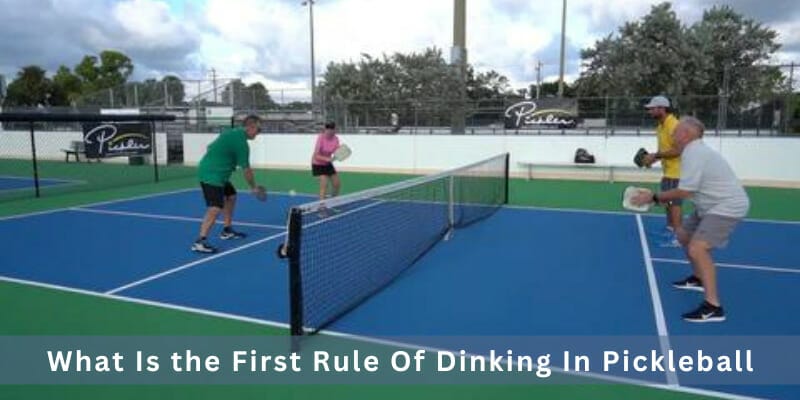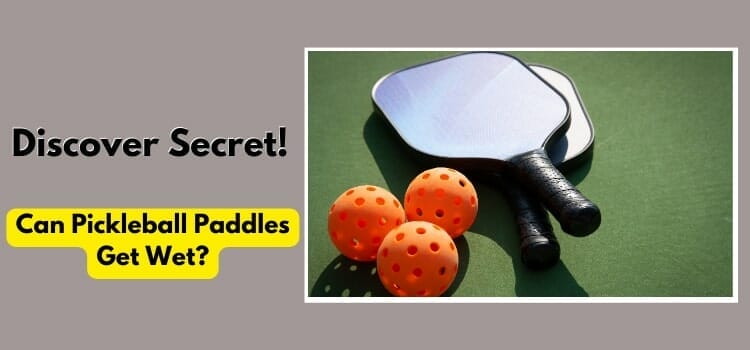What Is the First Rule of Dinking in Pickleball | Complete Guide

The first rule of successful dinking in pickleball is to aim for accuracy rather than power, placing the ball in areas where your opponent can’t reach it.
The first rule of dinking in pickleball is to keep the ball low over the net and close to the net, making it difficult for your opponent to attack. This shot requires practice, touch, patience, and precision to control the pace and keep your opponent guessing.
I recall my first pickleball game. I was eager to show off my skills and kept smashing every ball that came my way.
A player approached me and advised the first rule of dinking: don’t always go for the big hit, slow down and try to control the ball. It helped me improve my game.
Are you curious about “what is the first rule of dinking in pickleball?” Look no further! This article will explain everything you need to know.
Without further ado, let’s dig into it!
What is dinking in pickleball?
In pickleball, “dinking” refers to hitting a soft and short shot over the net, landing it just over the opponent’s side of the court.
An effective pickleball dink shot is typically used to start a rally, to gain control of the net, or to force the opponent to make a mistake.
The goal of dinking is to place the ball in a spot that is difficult for the opponent to return a dink, while also maintaining control and keeping the ball in play.
Dinking is an essential technique in pickleball, and it requires a delicate touch, good hand-eye coordination, and precise control of the pickleball paddle.
Importance of Dinking in Pickleball
The first rule of dinking in pickleball is an essential technique that players need to master to improve their game. Here are some of the reasons why dinking is essential:
1. Control
Dinking helps players control the pace of the game by slowing it down and making it more strategic. By keeping the ball low and slow, players can create opportunities for winning shots and put pressure on their opponents to make a mistake.
2. Accuracy
Dinking helps players improve their accuracy by practicing the delicate touch required to make the shot.
By aiming for specific spots on the court, players can force their opponents to move and create openings for them to make a winning shot.
3. Energy Conservation
Dinking is a less physically demanding shot than hitting the ball hard and fast. By incorporating dinking into their game, players can conserve their energy and stay in the game for longer periods of time.
4. Unforced Errors
Dinking helps players reduce unforced errors by keeping the ball low and reducing the chances of their opponent making a powerful return. By following the first rule of dinking, players can avoid making errors that can cost them points.
5. Versatility
By mastering dinking, players become more versatile and well-rounded on the court. They can switch up their pickleball strategy and play style, making it more difficult for their opponents to anticipate their moves and giving them a greater advantage in the game.
The first rule of dinking is an important technique for players to learn and incorporate into their game. By using it strategically, players can gain control over the game and increase their chances of winning.
What is the first rule of dinking in pickleball? – Complete Guide
The first rule of dinking in pickleball is to keep the ball low and slow, aiming for the opponent’s feet while hitting the ball gently over the net.
This shot is typically executed from the non-volley zone and is an effective way to control the pace of the game and create openings for winners.
The first rule of dinking is important because it helps players maintain control over the game of pickleball by keeping the ball low, reducing the chances of their opponent making a powerful return.
When executed correctly, dinking can also create opportunities for players to make winning shots or put pressure on their opponents to make mistakes.
By following the first rule of dinking in pickleball, players can also avoid making errors that can cost them points.
Hitting the ball too high or hard can give the opponent an advantage and make it difficult to regain control of the game.
In addition, mastering the art of dinking in pickleball can improve a player’s overall game and make them a more well-rounded and versatile player on the court.
It can also help players conserve their energy by slowing down the pace of the game, allowing them to stay in the game for longer periods of time.
It is an essential technique that you should learn and incorporate into your game. It not only helps you maintain control over the game but also creates opportunities for strategic play and ultimately leads to better performance on the court.
Different types of dinking techniques in pickleball
There are several different dinking techniques that players can use, depending on their position on the pickleball court and the situation at hand.
Here are some of the most common dinking techniques in pickleball:
1. Cross-Court Dink
This technique involves hitting the ball straight across or diagonally across the court, aiming for the opponent’s non-dominant side.
It’s a great way to open up the court and create opportunities for a winning shot.
2. Straight-Ahead Dink
With this technique, players hit the ball straight ahead, right at their opponent. It’s an effective way to catch your opponent off-guard and create a point-winning opportunity.
3. Backhand Dink
The backhand dink is executed with the backhand paddle, and it’s a great way to mix up your shots and keep your opponent guessing. It’s especially useful when you’re in a defensive position on the court.
4. Drop Shot
The drop shot is a type of dink that involves hitting the ball lightly over the net, causing it to drop just inside your opponent’s court.
It requires excellent control and touch, but it can be a devastating shot when executed correctly.
5. Lob Dink
The lob dink in pickleball is a high-arching shot that you hit clears the net and lands deep in your opponent’s court.
It’s a great way to change up the pace of the game and create opportunities for attacking shots.
6. Angle Dink
The angle dink is similar to the cross-court dink, but it’s hit at a sharper angle, making it more difficult for your opponent to return a cross-court dink.
It’s a great way to create openings on the court and force your opponent to move quickly.
7. Soft Block Dink
The soft block dink is a defensive technique that involves blocking the ball back over the net with minimal force.
It’s a good option when you’re caught out of position or when your opponent hits a hard, low shot.
8. Spin Dink
The spin dink is a technique that involves adding spin to the ball as you hit it, causing it to bounce unpredictably on your opponent’s side of the court.
It requires excellent touch and control, but it can be a highly effective way to create openings and win points.
How to practice the first rule of dinking in pickleball
Here are some tips for practicing and mastering the first rule of dinking in pickleball:
1. Start slow
Begin by practicing your dinks slowly and deliberately, focusing on accuracy and placement rather than power.
As you become more comfortable with the technique, you can gradually increase your speed and intensity.
2. Use drills
There are a variety of drills you can use to improve your dinking skills, such as the two-person dink and third shot drills.
These drills can help you develop your touch, control, and consistency.
3. Work on footwork
Good footwork is essential for effective dinking, as it allows you to move quickly and get into position for each shot.
Practice moving smoothly and efficiently around the court and focus on staying balanced and in control.
4. Watch the ball
When dinking, it’s important to keep your eye on the ball at all times. This will help you anticipate the ball’s trajectory and make quick, accurate shots.
5. Practice with a partner
Keep practicing with a partner is one of the best ways to improve your dinking skills.
Try to find someone with similar skill level and practice different pickleball dinking strategies and techniques together.
This will help you develop your skills in a realistic game situation.
6. Vary your shots
Don’t just stick to one type of dink, but instead, try to mix it up and use different techniques to keep your opponent guessing.
Vary the height, speed, and placement of your shots to create different angles and openings on the court.
7. Focus on soft hands
To make accurate dinks, it’s important to have soft and relaxed hands. Practice hitting the ball with a light touch and focus on using your wrists to generate spin and control.
8. Stay patient
Dinking can be a slow and strategic part of the game, so it’s important to stay patient and wait for the right opportunity to attack. Avoid rushing your dinking shots or trying to force openings that aren’t there.
9. Analyze your opponents
Pay attention to your opponents’ strengths and weaknesses and adjust your dinking strategy accordingly.
If they’re struggling with low shots, for example, try to use more drop shots to keep them off balance.
10. Get feedback
Finally, don’t be afraid to ask for feedback from more advanced players or coaches. They can help you identify areas for improvement and give you tips for refining your dinking game.
Common Dinking Mistakes to Avoid in Pickleball
Dinking is an essential technique in pickleball, but many players make common mistakes that can negatively impact their game.
Here are some common mistakes that you should avoid:
1. Hitting the ball too hard
One of the most common dinking mistakes is hitting the ball too hard, which can result in the ball going out of bounds or giving your opponent an easy put-away shot.
This violates the first rule of dinking, which emphasizes the importance of keeping the ball low and controlled.
2. Not following through
Another mistake is not following through with your shot, which can cause the ball to sail or fall short.
Make sure to follow through with your swing and focus on making contact with the ball in the center of your paddle face.
3. Using too much wrist
While using your wrist can be effective for generating spin, overusing it can lead to inconsistent shots and lack of control.
Focus on using your whole arm and maintaining a stable wrist.
4. Dinking from too far back
Standing too far back from the net can make it harder to control the ball and limit your options for placement.
Try to move closer to the net and take advantage of the short distance to make more effective dinks.
5. Telegraphing your shots
Finally, telegraphing your shots by giving away your intentions too early can make it easier for your opponent to hit your dinks and respond accordingly.
Try to vary your shots and keep your opponent guessing to make it more challenging for them to anticipate your next shot.
By avoiding these common mistakes, you can improve your dinking skills and play more effective and controlled shots that adhere to the first rule of dinking.
Key takeaways and tips for improving dinking skills
Here are some key takeaways and tips that you should consider:
- The first rule of dinking is to aim for the kitchen and keep the ball low.
- There are different dinking techniques such as the backhand and forehand dink, cross-court dink, and lob dink.
- Common dinking mistakes include hitting the ball too hard, aiming too high, and not anticipating your opponent’s shot.
- To avoid these mistakes and improve your dinking skills, practice regularly, vary your techniques, and work on your footwork and positioning.
Conclusion
In conclusion, the first rule of dinking in advanced pickleball is essential for players to master if they want to improve their game play and win more matches.
By hitting the ball softly and accurately over the net, players can force their opponents into making mistakes and gain an advantage on the court.
It is important to remember to always follow the first rule of dinking by aiming for the kitchen and keeping the ball low, as this will prevent your opponent from smashing the ball and giving you control of the point.
If you want to take your pickleball game to the next level, start incorporating the first rule of dinking into your game play.
With practice and dedication, you can master this important technique and become a more competitive and skilled player on the court.
FAQs
What Are The Basics Of Dinking In Pickleball?
Dinking in pickleball is a soft shot hit with a paddle that lands in the non-volley zone. The goal is to force your opponent to hit up, giving you a chance to hit an attacking shot.
What Is The Dink In Pickleball?
In pickleball, the dink is a soft shot, hit with a paddle, that lands in the non-volley zone, just over the net, usually played as a response to a hard-hit ball. Its purpose is to force the opponent to hit up and create an opportunity to win the point.
Do You Have To Dink In Pickleball?
No, dinking is not a requirement in pickleball. However, it is a valuable technique that can help you control the pace of the game and create opportunities to win points. It’s important to have a variety of shots in your repertoire to keep your opponent guessing.
What Are The 5 Basic Rules Of Pickleball?
The five basic rules of pickleball are:
(1) serve the ball underhand,
(2) allow the ball to bounce once on each side,
(3) do not step into the non-volley zone to hit a volley,
(4) play to 11 points (win by 2), and
(5) play with a paddle and a plastic ball.






